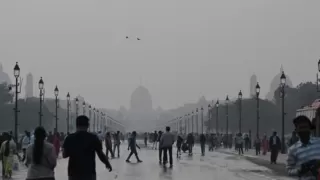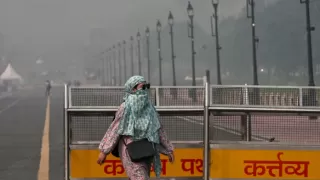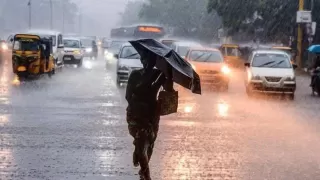Southern and eastern India are facing an intense spell of rainfall and thunderstorms as the India Meteorological Department (IMD) issues warnings for widespread showers and potential flood risks until October 26. The northeast monsoon has intensified, affecting both coastal and interior regions of the southern peninsula. Authorities are urging residents to remain vigilant as heavy downpours, strong gusty winds, and lightning are expected to accompany the rains over the coming week.
The IMD's advisory highlights that states including Tamil Nadu, Kerala, Karnataka, Andhra Pradesh, Telangana, and the Lakshadweep Islands are likely to receive light to moderate rainfall at most places, while some areas may witness very heavy to extremely heavy rainfall. The combination of intense precipitation, saturated soil conditions, and rising river levels could increase the risk of flash floods, landslides, and urban waterlogging, especially in low-lying and hilly regions.
State-wise Rainfall & Flood Breakdown
Tamil Nadu: The state has been placed under an orange alert as very heavy rainfall is expected in coastal and adjoining interior districts, including Chennai, Cuddalore, Nagapattinam, and Tiruvallur. Thunderstorms, lightning, and gusty winds are also forecasted, making travel potentially hazardous. Residents are advised to stay indoors during high-intensity rainfall periods and avoid non-essential travel, especially in flood-prone areas.
Authorities in Tamil Nadu have also been monitoring river levels in key districts, preparing for potential overflow and waterlogging. Emergency response teams are on standby to respond quickly to any flood situations, and public advisories are being continuously issued to alert residents about areas that may experience sudden water accumulation.
Kerala & Mahe: Central and northern districts such as Idukki, Wayanad, Kozhikode, and Malappuram are expected to experience continuous heavy rainfall from October 22 to 24. Given the high terrain and already saturated soil, there is a significant risk of flash floods and landslides in these regions. Local authorities are coordinating with disaster management teams to ensure timely warnings and evacuations if necessary.
Low-lying areas in Kerala, including Kottayam, Palakkad, Pathanamthitta, and Malappuram, are being closely monitored for flooding. Residents in flood-prone neighborhoods are being advised to move to safer locations, secure essential items, and avoid travelling during peak rainfall periods to minimize risks associated with waterlogging and strong winds.
Karnataka: Coastal and interior districts are expected to witness intermittent heavy rainfall until October 25. South-interior districts like Bengaluru, Mysuru, and Hassan may experience thunderstorms and gusty winds on October 24-25, posing challenges for traffic management and urban drainage systems. Authorities have issued alerts to ensure preparedness for any localized flooding or disruption in infrastructure.
Disaster management teams in Karnataka are coordinating with local administrations to keep roads and highways under observation for water accumulation. Public advisories recommend citizens to monitor weather updates closely and take precautionary measures in vulnerable regions, especially where drainage infrastructure may be inadequate to handle sudden heavy rains.
Andhra Pradesh & Rayalaseema: The coastal and southern districts of Andhra Pradesh will likely face sustained wet weather through October 25. Areas like Chittoor, Kadapa, and Nellore are under particular scrutiny due to expected very heavy rainfall. Flood alerts have been issued for districts in Rayalaseema to prevent loss of life and property, as rivers and streams in these regions may overflow.
Authorities in Andhra Pradesh have been conducting inspections of embankments, reservoirs, and drainage systems to ensure that they can withstand heavy rainfall. Emergency shelters and response teams are ready to assist residents in low-lying areas, and citizens are encouraged to stay updated on official advisories to avoid hazardous situations.
Telangana: Heavy rainfall is forecasted from October 23 to 25, accompanied by thunderstorms and gusty winds in many districts. Urban centers may experience waterlogging, and authorities are cautioning residents to avoid travel during periods of heavy downpour. Lightning strikes and strong winds pose additional hazards, especially in outdoor areas and during night-time hours.
Local administrations in Telangana are preparing to respond to potential road closures and minor flash flood incidents. Residents are being advised to secure loose objects and maintain emergency supplies, including essential medicines, food, and water, to navigate the potential challenges posed by extreme weather conditions.
Eastern & Central States / Islands: The Andaman and Nicobar Islands are expected to experience multiple spells of rainfall between October 21 and October 26. Thunderstorms, lightning, and gusts of 30–50 km/h may disrupt maritime activities and small boat operations. Parts of Odisha and adjoining areas are forecasted to receive moderate to heavy rainfall with thunderstorms till October 24, while Madhya Pradesh, Vidarbha, and Chhattisgarh may also experience similar weather patterns from October 21–23.
Western states, including Konkan, Goa, Marathwada, and parts of Maharashtra, are expected to have isolated thunderstorms till October 22. While rainfall intensity will be lower compared to southern states, authorities have advised caution for travellers and farmers. Northern hill states like Himachal Pradesh and Uttarakhand may witness brief thunderstorm activity around October 21.
Flash-Flood Risks and Vulnerable Zones
The IMD has issued low to moderate flash-flood warnings for districts across Kerala, Tamil Nadu, and Andhra Pradesh’s Rayalaseema region. In Kerala, Idukki, Wayanad, Kozhikode, Kottayam, Palakkad, Pathanamthitta, and Malappuram are most vulnerable due to saturated soils and ongoing heavy rainfall.
In Rayalaseema, Chittoor and Kadapa are flagged as flood-risk districts. Tamil Nadu’s coastal and interior districts including Chennai, Cuddalore, Nagapattinam, Kanchipuram, Tiruchirappalli, Madurai, and the UT of Puducherry are also under watch for potential waterlogging and flash floods. The risk is heightened due to rising river levels and overflowing drainage systems in many urban centers.
Preparedness Recommendations and Safety Measures
Authorities have urged citizens to follow local bulletins, avoid non-essential travel, and remain especially cautious in flood-prone areas. Fishermen and maritime operators are advised to suspend operations in the seas during thunderstorms and gusty winds. Residents in vulnerable zones should move to higher ground and secure essential belongings.
At the household level, people are recommended to ensure proper drainage around their homes, keep emergency kits ready, and avoid open fields, tall trees, and metal structures during thunderstorms. Travelers should monitor live weather updates to avoid roadblocks or flooded routes. Local administrations are coordinating with disaster response teams to provide timely assistance in case of emergencies.
Outlook & Importance of the Alert
This weather event represents a significant intensification of the northeast monsoon, affecting southern and eastern India simultaneously. The IMD’s alert emphasizes the need for preparedness, as saturated soils, strong winds, and heavy rainfall could result in localized emergency situations, infrastructure damage, and urban flooding.
Residents are urged to adhere strictly to official warnings and take precautionary measures to ensure safety. While rainfall is crucial for replenishing water resources, unchecked accumulation could lead to disruption in daily life, damage to property, and risk to human lives. Authorities continue to monitor the situation closely and will issue updates as conditions evolve over the next several days.
Also Read: President Murmu’s Helicopter Wheels Sink into Kerala Helipad


























